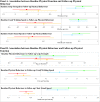Bidirectional associations of accelerometer-assessed physical activity and sedentary time with physical function among older English adults: the EPIC-Norfolk cohort study
- PMID: 36506675
- PMCID: PMC9729509
- DOI: 10.1007/s10433-022-00733-y
Bidirectional associations of accelerometer-assessed physical activity and sedentary time with physical function among older English adults: the EPIC-Norfolk cohort study
Abstract
To develop healthy ageing interventions, longitudinal associations between objectively assessed physical behaviours and physical function need to be better understood. We assessed associations between accelerometer-assessed total physical activity (PA), moderate-to-vigorous physical activity (MVPA), light physical activity (LPA), sedentary time and prolonged sedentary bout time, and clinically assessed physical function (grip strength, usual walking speed (UWS), chair stand speed) at two time-points in 3188 participants (≥ 60 years) of the EPIC-Norfolk study. Bidirectional associations were assessed using multivariable linear regression. Over an average of 6.1 years, baseline physical behaviours (greater total PA, MVPA and LPA, and less sedentary time) were associated with better subsequent walking and chair stand speed. Better baseline physical function was associated with better follow-up physical behaviours. There were no bidirectional associations between changes in physical behaviours and grip strength. Improvements in UWS were associated with improvements in all physical behaviours. Improvements in chair stand speed were associated with improvements in total PA, MVPA, and sedentary bout time. Improvements in physical behaviours were associated with improvements in UWS (3.1 cm/s/yr per 100 cpm/yr total PA, 3.6 cm/s/yr per hr/day/yr MVPA, 2.5 cm/s/yr per hr/day/yr LPA, - 2.9 cm/s/yr per hour/day/yr sedentary time, and - 1.6 cm/s/yr per hr/day/yr prolonged sedentary bout time). Only improvements in total PA, MVPA and sedentary bout time were associated with improvements in chair stand speed. In conclusion, we found bidirectional associations between changes in some physical behaviours and physical function and between baseline physical behaviours and subsequent physical function, highlighting the importance of considering the full range of physical behaviours to promote healthy ageing.
Supplementary information: The online version contains supplementary material available at 10.1007/s10433-022-00733-y.
Keywords: Older adults; Physical activity; Physical function; Sedentary time.
© The Author(s) 2022.
Conflict of interest statement
Conflicts of interestThere are no conflicts of interest declared. Ethical approval Ethical procedures in this study were approved by the Norfolk Local Research Ethics and East Norfolk and Waveney NHS Research Governance Committee. EPIC was closely monitored both internally by the University of Cambridge and externally by various governing committees such as the Local Research Ethics Committee and Confidentiality Advisory Group (CAG) of the Health Research Authority. The EPIC-Norfolk Approval Board approved access to data from the study, with all released data already anonymised.
Figures


Similar articles
-
Associations between change in physical activity and sedentary time and health-related quality of life in older english adults: the EPIC-Norfolk cohort study.Health Qual Life Outcomes. 2023 Jun 22;21(1):60. doi: 10.1186/s12955-023-02137-7. Health Qual Life Outcomes. 2023. PMID: 37349799 Free PMC article.
-
Prospective associations between changes in physical activity and sedentary time and subsequent lean muscle mass in older English adults: the EPIC-Norfolk cohort study.Int J Behav Nutr Phys Act. 2024 Jan 26;21(1):10. doi: 10.1186/s12966-023-01547-6. Int J Behav Nutr Phys Act. 2024. PMID: 38279174 Free PMC article.
-
Associations between accelerometer-measured physical activity and sedentary behaviour with physical function among older women: a cross-sectional study.BMC Public Health. 2024 Jul 2;24(1):1754. doi: 10.1186/s12889-024-19270-7. BMC Public Health. 2024. PMID: 38956531 Free PMC article.
-
Objective Sedentary Time, Moderate-to-Vigorous Physical Activity, and Physical Capability in a British Cohort.Med Sci Sports Exerc. 2016 Mar;48(3):421-9. doi: 10.1249/MSS.0000000000000785. Med Sci Sports Exerc. 2016. PMID: 26501232 Free PMC article.
-
Objectively assessed physical activity and sedentary behavior and global cognitive function in older adults: a systematic review.Mech Ageing Dev. 2021 Sep;198:111524. doi: 10.1016/j.mad.2021.111524. Epub 2021 Jun 25. Mech Ageing Dev. 2021. PMID: 34181963
Cited by
-
24-hour activity composition is associated with lower fall and fracture risk in older men.J Bone Miner Res. 2024 Dec 31;40(1):27-37. doi: 10.1093/jbmr/zjae160. J Bone Miner Res. 2024. PMID: 39348414
-
Data Analytics in Physical Activity Studies With Accelerometers: Scoping Review.J Med Internet Res. 2024 Sep 11;26:e59497. doi: 10.2196/59497. J Med Internet Res. 2024. PMID: 39259962 Free PMC article.
-
Changes in anticholinergic cognitive burden and risk of single and recurrent falls: population-based cohort study.Age Ageing. 2025 May 31;54(6):afaf177. doi: 10.1093/ageing/afaf177. Age Ageing. 2025. PMID: 40586120
-
Associations between device-measured physical activity and performance-based physical function outcomes in adults: a systematic review and meta-analysis.BMJ Public Health. 2023 Oct 30;1(1):e100000. doi: 10.1136/bmjph-2023-100000. eCollection 2023 Nov. BMJ Public Health. 2023. PMID: 40017839 Free PMC article. Review.
-
Associations between change in physical activity and sedentary time and health-related quality of life in older english adults: the EPIC-Norfolk cohort study.Health Qual Life Outcomes. 2023 Jun 22;21(1):60. doi: 10.1186/s12955-023-02137-7. Health Qual Life Outcomes. 2023. PMID: 37349799 Free PMC article.
References
Grants and funding
LinkOut - more resources
Full Text Sources
Miscellaneous

